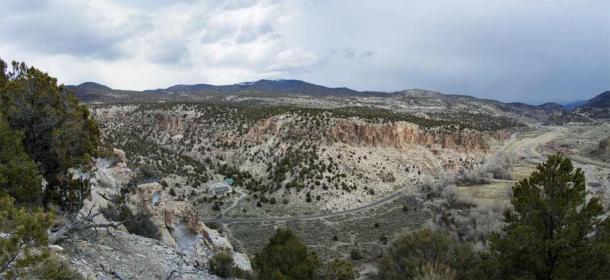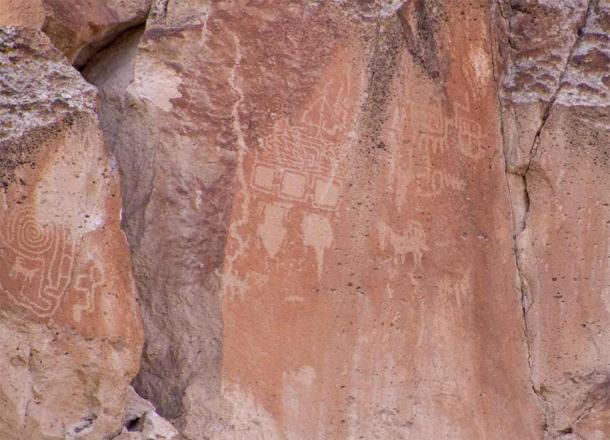Clear Creek Canyon is a three-mile-long desert ravine located in south-central Utah in the United States. A small stream runs down its center, running along an interstate highway and flowing by a large hill that stands like a sentinel near the west end. The hill is significant as it is the location of the largest Fremont Indian settlement ever discovered and a treasure of petroglyphs. The hill and canyon became a heritage site and Fremont Indian State Park was established in 1987 to commemorate the find.

Clear Creek Canyon, Panorama, taken from an opposing bluff. (Photo © John Lundwall)
The Fremont Indians were a Native American culture group occupying the mountains and deserts of what is now known as Utah from between 300 to 1300 AD. They left behind no writing, but numerous artifacts have been discovered, including pottery, metates, pipes, moccasins, tools, and arrowheads. Significantly, the Fremont also left behind tens of thousands of petroglyphs-–images carved in stone depicting a variety of motifs, including deer, sheep, birds, plants, corn, geometric shapes, and a large variety of humanoid forms.

A humanoid figure holds a ceremonial staff and basket in the upper left, while stylized sheep are framed by a pair of spirals; Fremont Indian State Park. (Photo © John Lundwall)
The humanoid figures are called anthropomorphs, and the Fremont had a unique style when carving these images. Fremont anthropomorphs have trapezoidal bodies, with wide shoulders and narrower waists. Many of the figures appear to be deities, as they are depicted with divine headdresses or unique, symbolic motifs.

Located high up on a cliff face, the three squares in the center of the image have been interpreted as the three worlds of Fremont cosmology (underworld, material world, and upper world); Fremont Indian State Park. (Photo © John Lundwall)
There are over 3,600 petroglyphs in Clear Creek Canyon. One in particular caught the attention of Dr. John Lundwall, who in May of 2017 was running a star party for the Park as part of its dark sky’s initiative. Star watching has become a favorite past time for visitors, and dark skies are a treasured natural resource of this landscape. Utah has more dark sky sites registered with the International Dark Skies Association (IDA) than anywhere else in the world.
Like this Preview and want to read on? You can! JOIN US THERE ( with easy, instant access ) and see what you’re missing!! All Premium articles are available in full, with immediate access.
For the price of a cup of coffee, you get this and all the other great benefits at Ancient Origins Premium. And – each time you support AO Premium, you support independent thought and writing.
John Lundwall holds a doctorate in comparative myth and religion from the Joseph Campbell school of myth studies, Pacifica Graduate Institute. He is a founding board member of the Utah Valley Astronomy Club investigating the cultural astronomy of the ancient Fremont Indian, a Native American culture group associated with the American Southwest that inhabited the land of present-day Utah between 300 and 1300 AD.
John McHugh earned a Master’s degree from Brigham Young University with a dual emphasis on Near Eastern and Native American Archaeology. He specializes in Near Eastern and Native American archaeoastronomy as well as American Indian rock art. He serves on the Board at the Utah Rock Art Research Association. His current book, The Celestial Code of Scriptures (Monkfish Publishing), will appear in Autumn, 2021.
Top Image : The Rochester Panel is a mythological tableau, depicting people, deities, strange creatures, birds, and other symbolic forms; Emery, Utah. Photo by John Lundwall
By John Knight Lundwall , and John McHugh
Related posts:
Views: 0
 RSS Feed
RSS Feed

















 March 2nd, 2021
March 2nd, 2021  Awake Goy
Awake Goy  Posted in
Posted in  Tags:
Tags: 
















